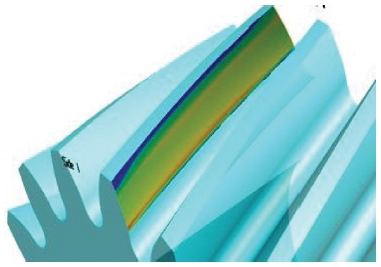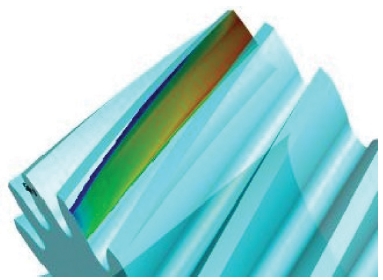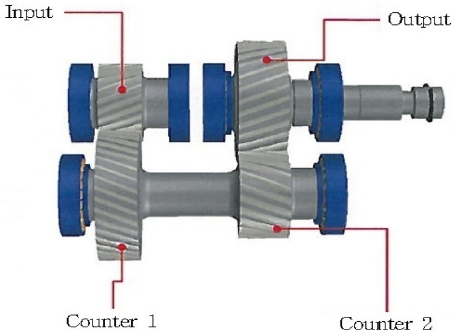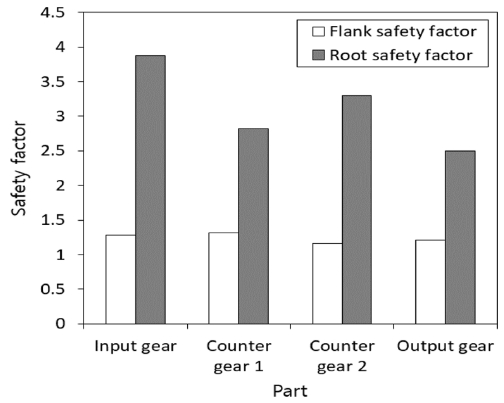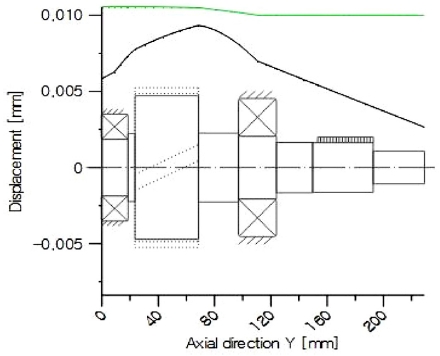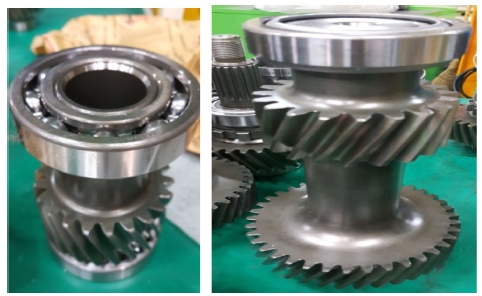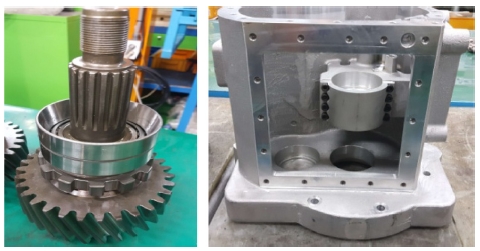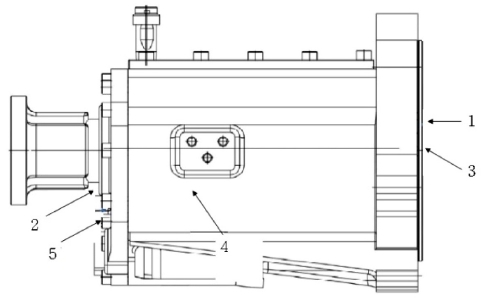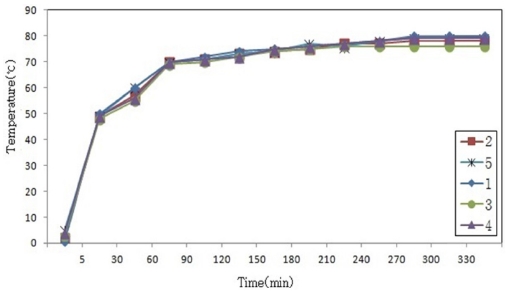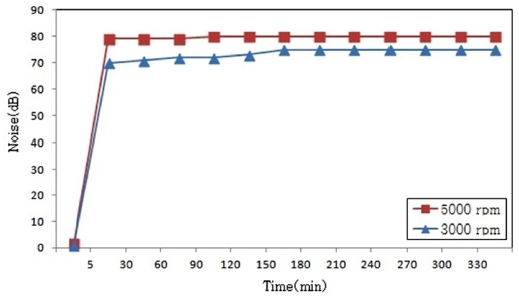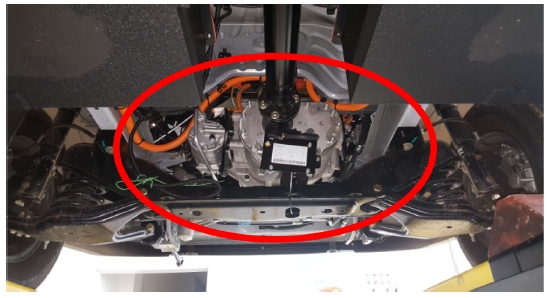
A Study on the Design of Rear Wheel Drive Reducer for Electric Vehicle
Copyright © The Korean Society for Precision Engineering
This is an Open-Access article distributed under the terms of the Creative Commons Attribution Non-Commercial License (http://creativecommons.org/licenses/by-nc/3.0) which permits unrestricted non-commercial use, distribution, and reproduction in any medium, provided the original work is properly cited.
Abstract
The aim of this study is to design the gearbox of an electric vehicle using the rear-wheel drive. The gearbox is a set of revolving gears and shafts based on programmed torque and rotations per minute (rpm). In this case, safety, strength and durability of gears and shafts was considered. In the narrow vehicle, a light case is used. In addition to gear safety and deflection, the weight of the vehicle was reduced. The electric vehicle reducer gearbox was modeled according to the vehicle room. The strength analysis was conducted using finite element method (FEM). After analyzing the strength using FEM to verify stress distribution, the design was modified, and compared with the results of altered design using FEM. As a result, the reducer gearbox of electric vehicle was designed according to incorporate gear safety, deflection of each gear, durability, and analysis of finite elements followed by test assessment, vehicle installation and the production of real parts.
Keywords:
Electric vehicle reducer, Gearbox, Rear wheel drive system, Gearbox design, Reduction gears키워드:
전기차량 감속기, 기어박스, 후륜구동 시스템, 기어박스설계, 감속기어1. Introduction
The earth climate already changed due to the exhausts greenhouse gases and other reasons. Many researches on electric vehicles that use electricity as an alternative to environmental problems due to the use of fossil fuels and high price of crude oil era have been conducted, under the global proposition of finite resources and environmental protection such as depletion of oil resources and global warming, world automakers are increasingly interested in Eco-friendly electric vehicles.
From this viewpoint, it is inevitable to develop electric vehicles that have characteristics of pollution-free of industrial facilities and transportation means while looking at the 21st century.1,2 Vehicles in Korea use two kinds of driving systems, front wheel drive system and rear wheel drive system. In the case of domestic automobiles, the front wheel drive system is used for passenger vehicles and the rear wheel drive system is used for commercial vehicles. In Korea, electric vehicles in the commercialization stage are mostly passenger cars, while researches on front wheel drive systems have been studied a lot, on the other hand, researches on reduction gears of a rear wheel drive system of commercial vehicles is insufficient, so research on the rear wheel drive system is necessary.
Domestic car companies mainly produce and sell passenger cars driven by front wheel. Because there is not much demand for rear-wheel-drive electric vehicles in the domestic market, in order to produce a rear-wheel-drive electric vehicle, it is necessary to import the reducer of a rear-wheel-drive electric vehicle from overseas.
Therefore, studies on the reducer of rear-wheel-drive electric vehicle that can be applied to commercial vehicles and special vehicles in the domestic market are urgently required.
The whole world is intensely developing efforts to solve energy and environmental problems, among these, transportation sector is the main factor of these problems, especially in the automotive sector, research and development which is looking for replacement is conducted on a national level.3
In addition to H cars in the domestic market, other automobile manufacturers also have released eco-friendly hybrid vehicles. Kim et al. have conducted research on transmissions for electric vehicles,4 Cho et al. are conducting research on prediction of noise of transmission from researches on transmission error.5-9
As the strengthened exhaust gas regulations and the high oil prices continue, the worldwide automobile industry has further strengthened the development speed of electric vehicles. The market size of electric vehicles is rapidly growing. In the case of China, the size of electric car market is expected to grow to 22 billion dollars (about 319 trillion won) in 2020.10 Many companies such as China BYD, American GM, Japan’s Toyota are accelerating the development of electric vehicles.
Especially the growth trend is remarkable, the electric vehicle market in Europe and China two regions all recorded growth rate more than 200% than the previous year. Among the remarkable growth factors of these electric vehicles markets, the US and European automakers who did not respond much to products of electric vehicles and plug-in hybrid vehicles so far, and is expanding the aggressive attitude of developing plug-in hybrid products.
Especially European major automobile manufacturers mostly have entered the market of electric cars and plug-in hybrid cars from 2014 to 2016, and B cars etc. have the type of plug-in hybrid cars throughout all of the conventional gasoline car lines.
In addition, in the Chinese market, not only the plug-in hybrid car but also the growth of the electric car market is outstanding. Most Chinese automobile manufacturers are participating in this market, and sales volume has largely increased with the support of the Chinese government’s new energy vehicle spreading measures.11 The Chinese market is rapidly developing, and domestic electric vehicle research and development is also actively carried out to meet the demand of Chinese companies' electric vehicle.
There are various methods for the deceleration drive system of the electric vehicles, in-wheel speed reducer transmits the power to the wheel directly which is located in each wheel of the car, and another type that using a motor to replace traditional engine, it can be divided into FF (Front engine Front wheel drive) type, FR (Front engine Rear wheel drive) type and RR (Rear engine Rear wheel drive) type. In the FF type, a power source is positioned in front of the vehicle to drive the front wheels, in the FR type, a power source is positioned in front of the vehicle, and the rear wheel is driven. Likewise, RR is a system which disposes the power source behind the vehicle and drives the rear wheels. Currently the FF type is widely applied to passenger cars, and RR is a type usually applied to large buses. In this research, we studied on the FR type which power source (electric motor) is positioned as speed reducer in the front to drive the rear wheels. This system is a vehicle system that is often applied to trucks of 1 ton or more.
Development of in-wheel speed reducers for electric vehicles has been actively developed in Korea for the last 4 to 5 years, but this type is problematic if a motor and speed reducer must be installed in the limited space of the wheel. While considering strength problems and noise problems, the FR type has the advantages of the marketability of commercial vehicles with less space constraints and the ability to mount the center of the truck.
In this research, we designed a gear box of an electric car speed reducer used for rear wheel drive vehicles, rather than the front wheel drive type electric vehicles, which is produced by domestic major companies exclusively, it is able to respond the changes of the market as an eco-friendly vehicle. Also, in the environmental part, it is urgently necessary to reduce the use of fossil fuel vehicles within a few years, so we conducted this research to meet future demand. An electric motor used in an electric vehicle drives a vehicle using a speed reduction gear which has a fixed reduction ratio.12
The structure of the reduction gearbox of the electric car of this research is connected to the motor in terms of its structure, maintenance of seamless oil circulation to the space between the case, shaft and gear etc. Comparative analysis was conducted through CAE analysis to confirm whether reinforcement of the stress concentration was optimally designed.
Because the internal high speed gear is sensitive to noise and heat generation, the safety factor of the gears and shaft driven inside were taken into account in the strength analysis, and the gear design was optimized.
2. Design of Reducer Gearbox
2.1 Gear Design
The material of gears and shafts was selected as SCM 420, and the surface hardening method was chosen as the common carburizing heat treatment. The mechanical properties of the gear material are shown in Table 1 The heat treatment design of the gear was carried out by the optimum hardening depth carburizing heat treatment conditions.
2.2 Design of Gear Tooth Profile
Gear noise was effected by the tooth shape and mesh of tooth surfaces. The non-central part of the tooth surface during rotation drive affects the strength and noise, so KiSSsoft was used to analyze the stress distribution. Since it is very important to correct the tooth profile of important elements affecting the noise of the gear, the tooth profile of the gear was corrected and the optimum tooth profile was corrected before manufacturing as described above. Modify the crown, involute and lead to make sure of the stress distribution concentrate on the central part of the gear tooth surface during driving. Fig. 1 is the stress distribution before tooth profile modification, Fig. 2 is the stress distribution that the second tooth profile modification is applied. After multiple tooth profile modification, the optimum tooth surface stress distribution tooth profile design was carried out as shown in Fig. 3.
2.3 Design of Gear Strength
KiSSsoft was used for finding the safety factor in strength design of gears. Considering high speed rpm, level of gears was selected as ISO 5 tooth grinding specification. When executing the analysis, the application factor 1.0 was carried out with ISO 6336-1996 method, the flank safety factor was 1.1, and the root safety factor was 1.3 as the target.
In accordance with the requirement of the input unit vehicle, the maximum torque of 320 Nm of the motor was given, and according to the driving rpm, a rated rotation speed of 3,000 rpm, 400 hours was proceeded. Improvement of gear strength satisfying the reference safety factor was established by methods such as increasing tooth width, modifying module, and changing the modification coefficient. The position and name of each gear are shown in Fig. 4. After calculated the safety factor of each gear, the flank safety factor and the root safety factor were obtained and shown in Table 2 and Fig. 5.
Considering of the calculation result of safety factor, the weakest counter 2 appeared at a flank safety factor of 1.16, but since it meets the specification of flank strength safety, there is no serious problem in safety and durability was judged.
2.4 Axial Deflection Analysis
Since it is a shaft rotating body, deformation and deflection necessarily occurred during driving, axial deflection analysis was executed through the KiSSssoft program, and radial displacement was obtained. The input conditions were same as the calculation of the gear safety factor with the torque 320 Nm, 3,000 rpm, 400 hours. Fig. 6 shows the result value of deformation in the maximum radial direction of input part, Fig. 7 is the counterpart, and Fig. 8 is the output part. Table 5 shows the result of analysis of the deflection in each gear part.
As shown in the result of deflection, the front part of the input part, the middle part of the counterpart, the front part of the output part shows the maximum deflection, and the counterpart has the maximum deflection of 0.045 mm. It can be seen that the longest connection between the gear and gear showed the highest value. In general, it is judged that there is no big problem in durability while the value of deflection as a target of about 0.050 to 0.060 mm.
3. Production of Reducer Gearbox
Based on the gear optimum design, the gearbox was made by processing the prototype. Fig. 9 shows a 3D modeling and assembly photographs of housing and gearbox, and Fig. 10 shows the photographs showing press-fitted bearings of each gear. Fig. 11 shows the photographs of the output gear and the housing.
4. Test Results and Discussion
4.1 Temperature Measurement Result and Discussion
Fig. 12 shows the test apparatus including a motor, a speed reducer, a shaft, a load motor and the other parts. Since the motor output is immediately input to the gear box of the reducer, test was carried out at the time interval with the required torque and rpm of the vehicle, and temperature and noise were measured. Temperature measurements were carried out at an interval of each rpm, where is expected to be exothermic, Fig. 13 indicates a temperature measurement point, and Figs. 14 to 16 show the temperature value measured by classifying rpm by section.
As a result of temperature measurement test up to 8,000 rpm, the temperature of the gearbox did not exceed 50oC at 3,000 rpm and as a result of driving for 5 hours or more, the temperature did not rise anymore after about 1 hour from the start of driving. It reached equilibrium at 6,000 rpm at 75oC, the temperature rose suddenly after 10 minutes at maximum 8,000 rpm, but it did not rise above 80oC after 90 minutes was ascertained.
4.2 Noise Result and Discussion
As a result of the noise test as shown in Fig. 17, the noise was 80 dB at the input 3,000 to 5,000 rpm section which is the vehicle requirement condition. The durability test was conducted under the auspices of the vehicle manufacturer, after the durability test, the whole gearbox was disassembled to examine abnormal wear of gear teeth and breakage of the bearings, but any abnormal wear of the tooth surface and the bearing etc. was not found, it was confirmed that there was no big problem in durability.
4.3 Mounting under the Vehicle
After the test evaluation, the actual product was completed and installed in the lower end of the actual application vehicle for the real vehicle field test, and the mounting photograph is shown in Fig. 18. There was no problem mounted the reducer gearbox in the real vehicle.
5. Conclusion
In this paper, in designing the reducer gearbox of a rear wheel drive electric vehicle, safety factor analysis, shaft deflection analysis, life analysis of bearing and housing strength analysis were conducted to analyze the structure of the speed reducer gearbox of vehicle. Using strength analysis and design, make sure that both of the mechanism and function can meet the requirement. Through the design validation, the stability of the reducer gear box of the electric vehicle was verified, and after various kinds of test validation of prototype, the stability was finally demonstrated. Through the research of this paper, the following conclusions were derived.
(1) As the result of gear analysis, Counter 2 had the lowest flank safety factor of 1.16 and the overall gear root safety factor was more than 2.50. In the deflection analysis, the result was 0.045 mm at the counter part. There is no problem in durability.
(2) As a result of performing the temperature test up to 8,000 rpm, the gearbox temperature is displayed at 75oC at 6,000 rpm, not exceeding 50oC at 3,000 rpm and below 80oC at maximum 8,000 rpm. So it is designed appropriately could be confirmed.
(3) As a result of performing the noise test in the 3,000 to 5,000 rpm input which is vehicle required condition, the maximum noise was 80 dB.
(4) It was an appropriate design can be confirmed, there is no any abnormal wear of the gear tooth surface of the disassembled end of the durability test sample can be found.
The actual vehicle test is ongoing, the direction of the development and design of the speed reducer gear box of the electric car is presented, furthermore it will contribute to the improvement of the environment.
Acknowledgments
This study was supported by Basic Science Research Program through the National Research Foundation of Korea (NRF) funded by the Ministry of Education, Science and Technology (2016R1D1A1A09920105) & Romax Designer of Romax Technology.
REFERENCES
- Kim, H., Kim, Y., and Kim, H., “Effect of Changes in Metal Characteristics of Hot-Forged Alloy Steel on Mechanical Properties of an Automotive Automatic Transmission Gear,” Journal of the Korean Society of Manufacturing Process Engineers, Vol. 15, No. 3, pp. 135-146, 2016.
-
Zhang, Q., Wang, J. G., and Lyu, S. K., “Study on Empirical Gear Profile Micro-Modifications for Gear Transmission,” Journal of the Korean Society of Manufacturing Process Engineers, Vol. 16, No. 3, pp. 54-62, 2017.
[https://doi.org/10.14775/ksmpe.2017.16.3.054]

-
Lee, D. G., Zhen, Q., Jeon, M. H., Kim, L. S., and Lyu, S. K., “A Study on the Fabrication and Performance Evaluation of Worm Gear Reducer,” Journal of the Korean Society of Manufacturing Process Engineers, Vol. 17, No. 1, pp. 1-7, 2018.
[https://doi.org/10.14775/ksmpe.2018.17.1.001]

- Kim, J. M., “Efficiency Analysis Simulation of Electric Vehicle Transmission,” Proc. of Korean Society of Manufacturing Process Engineers, Spring Conference, p. 165, 2017.
- Houser, D. R., Harianto, J., and Ueda, Y., “Determining the Source of Gear Whine Noise,” Gear Solutions, http://gearsolutions.com/media/uploads/uploads/assets/PDF/Articles/2004-02-01_Determining_the_Source_of_Gear_Whine_Noise.pdf, (Accessed 15 MAY 2018)
-
Harianto, J. and Houser, D. R., “A Methodology for Obtaining Optimum Gear Tooth Micro-Topographies for Noise and Stress Minimization Over a Broad Operating Torque Range,” Proc. of the ASME International Design Engineering Technical Conferences and Computers and Information in Engineering Conference, pp. 289-303, 2007.
[https://doi.org/10.1115/DETC2007-34655]

- Welbourn, D. B., “Fundamental Knowledge of Gear Noise –A Survey,” Proc. of the Conference on Cranfield Institute of Technology, pp. 9-14, 1979.
-
Han, M. and Cho, J., “Strength Durability on Spur and Helical Gears in the Gearbox of Machine Tool,” Journal of the Korean Society of Manufacturing Process Engineers, Vol. 13, No. 3, pp. 103-110, 2014.
[https://doi.org/10.14775/ksmpe.2014.13.3.103]

- Lee, S., Lee, D. H., Hwang, S. C., and Lee, K. H., “Stress Analysis of Helical Gear for a Railway Reducer,” Journal of the Korean Society of Manufacturing Process Engineers, Vol. 11, No. 2, pp. 55-59, 2012.
- Jung, Y. W, Moon, B. J, Park, J. R, and Jung, G. S., “Electric Vehicle,” GSintervision, http://gsintervision.co.kr/xe/5930, (Accessed 15 MAY 2018)
- Lee, S. J., “Electric Vehicle and Global Car Trend Report,” NRT, http://www.kyobobook.co.kr/product/detailViewKor.laf?&mallGb= KOR&ejkGb=KOR&barcode=9791195985920&orderClick=LBB &Kc=SETRETAgendasearch, (Accessed 15 MAY 2018)
- Yun, G. B., Sim, J. S., Kim, S. S., and Lyu, S. K., “A Study on Design of Differential Gear Set for Electric Automobile,” Proc. of the Korean Society of Manufacturing Process Engineers, Spring Conference, p. 75, 2012.
-
Kim, H.-J., “Experimental Study on Production Characteristics of Straight Bevel Gear using a Polyjet Method 3D Printer,” Journal of the Korean Society of Manufacturing Process Engineers, Vol. 14, No. 6, pp. 63-68, 2015.
[https://doi.org/10.14775/ksmpe.2015.14.6.063]



